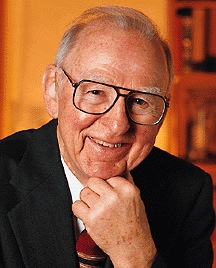Edwin G. Krebs
This articleneeds additional citations forverification.(February 2013) |
Edwin Gerhard Krebs | |
|---|---|
 Edwin Gerhard Krebs | |
| Born | June 6, 1918 |
| Died | December 21, 2009(aged 91) |
| Alma mater | University of Illinois Urbana–Champaign(B.S.), Washington University in St. Louis(M.D.) |
| Awards | Louisa Gross Horwitz Prize(1989) Welch Award in Chemistry(1991) Nobel Prize in Physiology or Medicine(1992) |
| Scientific career | |
| Fields | biochemistry |
| Institutions | University of Washington, Seattle University of California, Davis Washington University School of Medicine |
Edwin Gerhard Krebs(June 6, 1918 – December 21, 2009) was an American biochemist. He received theAlbert Lasker Award for Basic Medical Researchand theLouisa Gross Horwitz PrizeofColumbia Universityin 1989 together withAlfred Gilmanand, together with his collaboratorEdmond H. Fischer,was awarded theNobel Prize in Physiology or Medicinein 1992 for describing how reversiblephosphorylationworks as a switch to activateproteinsand regulate various cellular processes.
Early life and education
[edit]Krebs was born inLansing, Iowa,the third child of William Carl Krebs, aPresbyterianminister and Louise Helen (Stegeman) Krebs. The family moved frequently due to the nature of his father's work, though they settled inGreenville, Illinoiswhen Krebs was six and remained there until his father's unexpected death in 1933. Louise Krebs decided to move her family toUrbana, Illinois,where Krebs's elder brothers were attending theUniversity of Illinois Urbana–Champaign.Krebs attendedUrbana High School,and enrolled at the University of Illinois Urbana–Champaign in 1936. In his fourth year of study Krebs had decided to either pursue a higher degree inorganic chemistryor study medicine. Receiving a scholarship to attendWashington University School of MedicineinSt. Louis,he chose the latter.[1]
The School of Medicine afforded Krebs the opportunity to train as a physician as well as to gain experience in medical research. Following graduation in 1943, he undertook an 18-month residency atBarnes Hospitalin St. Louis and then went on active duty as a medical officer in theNavy.Krebs was discharged from the Navy in 1946 and was unable to immediately return to hospital work; he was advised to study basic science instead. He chose to studybiochemistryand was postdoctoral fellow toCarlandGerty Cori,working on the interaction ofprotaminewith rabbit musclephosphorylase.At the completion of his two years' study, Krebs decided to continue his career as a biochemist.[1]
Research work
[edit]In 1948 Krebs accepted a position as assistant professor of biochemistry at theUniversity of Washington,Seattle.[2]WhenEdmond H. Fischerarrived at the department in 1953, the pair decided to work on the enzymology ofphosphorylase.During the course of their study they were able to observe the mechanism by which interconversion of the two forms of phosphorylase takes place: reversible protein phosphorylation.[1]
Explained simply, in reversible protein phosphorylation aprotein kinasetakes aphosphategroup fromadenosine triphosphate(ATP) and attaches it to a specific site on a protein, introducing both extra mass and negative charge at that site. This can alter the protein's shape and turn its function in a biological process up or down, either by changing its activity or its ability to bind to another protein. The protein can be converted back to its original state by a proteinphosphatasethat removes the phosphate. This cycle controls numerous metabolic processes, and plays a central role in the regulation of cell division, shape, and motility. Derangement of specific protein phosphorylation pathways is important in human disease, including cancer and diabetes.[3]Fischer and Krebs were awarded the Nobel Prize for Physiology or Medicine in 1992 for the discovery of reversible protein phosphorylation.[4]
Later life and death
[edit]Krebs's interest in teaching and administration led him to leave the University of Washington to become the founding chairman of the department of biochemistry at theUniversity of California, Davis.In 1977 he returned to the University of Washington as chairman of the department ofpharmacology.[1]
Krebs was hearing impaired.[5]
Krebs died on December 21, 2009. His wife, Virginia, died in 2018.[6]He is survived by three children.[7][1]
References and notes
[edit]- ^abcde"The Nobel Prize in Physiology or Medicine 1992".NobelPrize.org.Retrieved2024-09-05.
- ^"Edwin Krebs".
- ^"Edwin Gerhard Krebs | Nobel Prize, Protein Phosphorylation, Biochemistry | Britannica".www.britannica.com.Retrieved2024-09-05.
- ^"The Nobel Prize in Physiology or Medicine 1992 Facts".NobelPrize.org.Retrieved2024-09-05.
- ^"Edwin G. Krebs | Biology Inclusion Committee | Washington University in St. Louis".sites.wustl.edu.Retrieved2022-10-24.
- ^"Virginia Krebs Obituary (1923 - 2018)".Legacy.com.Retrieved17 March2023.
- ^Altman, Lawrence K. (2009-12-24)."Edwin Krebs Dies at 91; Discovered a Crucial Bodily Process".The New York Times.Retrieved2009-12-25.
Bibliography
[edit]- Raju, T N (2000), "The Nobel chronicles. 1992: Edmond H Fischer (b 1920) and Edwin G Krebs (b 1918)",Lancet,vol. 355, no. 9219 (published Jun 3, 2000), p. 2004,doi:10.1016/S0140-6736(05)72951-2,PMID10859071,S2CID54322974
- Krebs, E G (1998), "An accidental biochemist",Annu. Rev. Biochem.,vol. 67, pp. xii–xxxii,doi:10.1146/annurev.biochem.67.1.0,PMID9759479
- Blum, H E (1992), "Nobel prize for medicine, 1992",Dtsch. Med. Wochenschr.,vol. 117, no. 50 (published Dec 11, 1992), pp. 1935–8,doi:10.1055/s-0029-1235415,PMID1333946
- Walaas, O; Jahnsen, T; Walaas, S I; Hansson, V (1992), "The 1992 Nobel Prize in physiology and medicine",Tidsskr. Nor. Laegeforen.,vol. 112, no. 30 (published Dec 10, 1992), p. 3775,PMID1485288
- Fredholm, B B (1992), "Two share the Nobel Prize in medicine this year",Läkartidningen,vol. 89, no. 43 (published Oct 21, 1992), pp. 3555–8, 363–4,PMID1334180
- Krebs, E G; Fischer, E H (1989), "The phosphorylase b to a converting enzyme of rabbit skeletal muscle. 1956",Biochim. Biophys. Acta,vol. 1000, pp. 302–9,doi:10.1016/s0006-3002(89)80024-1,PMID2505847
External links
[edit]- 1918 births
- 2009 deaths
- American biochemists
- Washington University School of Medicine alumni
- University of Washington faculty
- Nobel laureates in Physiology or Medicine
- American Nobel laureates
- People from Urbana, Illinois
- People from Bond County, Illinois
- University of Illinois Urbana-Champaign alumni
- Members of the United States National Academy of Sciences
- American Presbyterians
- American people of German descent
- Howard Hughes Medical Investigators
- People from Allamakee County, Iowa
- Recipients of the Albert Lasker Award for Basic Medical Research
- Washington University in St. Louis alumni
- University of California, Davis faculty

